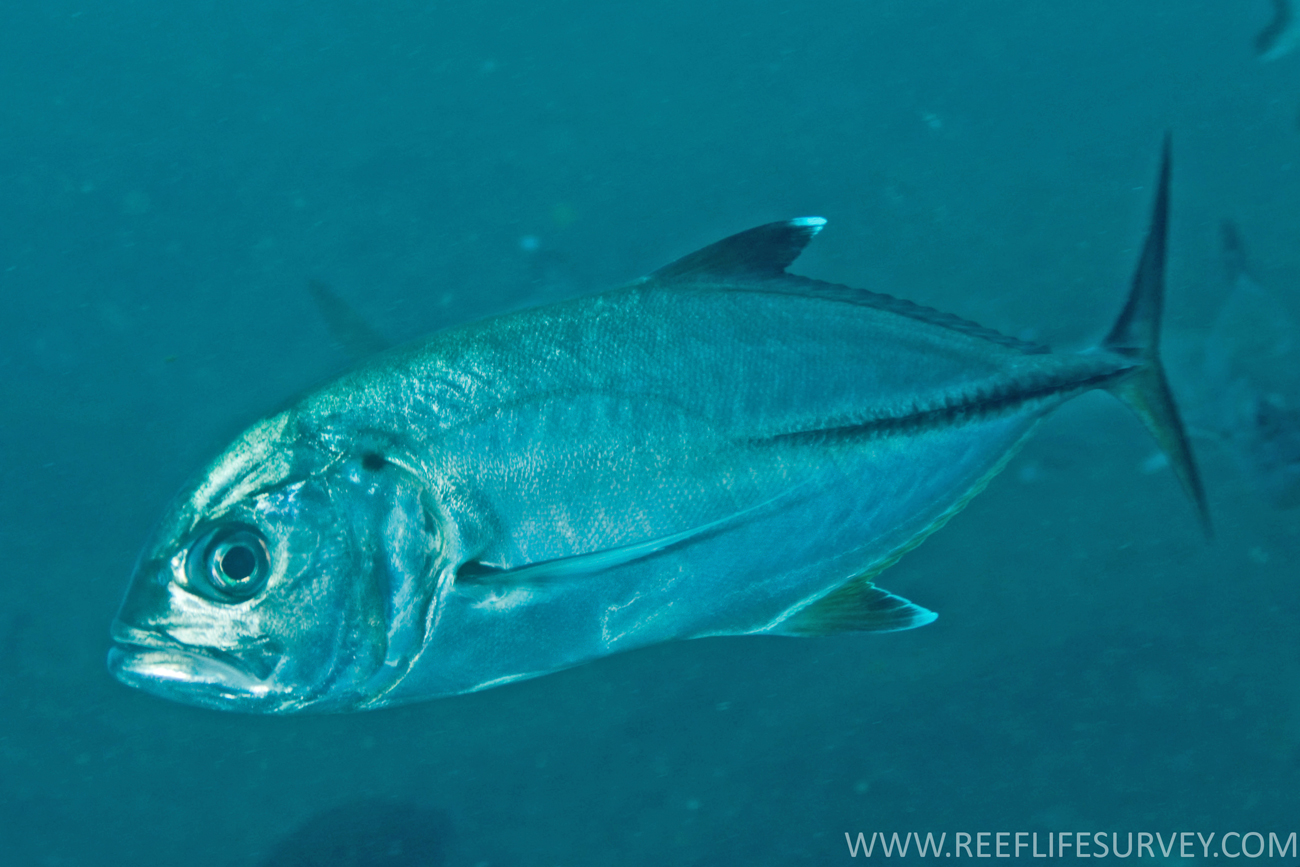- Classification
- ACTINOPTERYGII
- PERCIFORMES
- CARANGIDAE
- Caranx
- sexfasciatus
Bigeye Trevally, Caranx sexfasciatus Quoy & Gaimard 1825
Other Names: Big-eye Trevally, Great Trevally, Sixband Trevally, Six-banded Trevally, Turrum

A Bigeye Trevally, Caranx sexfasciatus, at the Solitary Islands, New South Wales. Source: Rick Stuart-Smith / Reef life Survey. License: CC by Attribution
Summary:
A large dark bluish-green to gold trevally, a paler yellowish-green to silvery below, with a dark caudal fin and dark grey to dusky tips on the soft dorsal and anal fins. Juveniles have 4-7 broad dark cross-bars, a round dark spot on the gill cover and a yellow caudal fin with black tip on the upper lobe.
Watch an amazing video of a huge school of Bigeye Trevally gathering to spawn.
Video of a huge school of Bigeye Trevally at the Gold Coast Seaway - by Ian Banks.
Watch an amazing video of a huge school of Bigeye Trevally gathering to spawn.
Video of a huge school of Bigeye Trevally at the Gold Coast Seaway - by Ian Banks.
Cite this page as:
Martin F. Gomon & Dianne J. Bray, Caranx sexfasciatus in Fishes of Australia, accessed 10 Jul 2025, https://fishesofaustralia.net.au/Home/species/1654
Bigeye Trevally, Caranx sexfasciatus Quoy & Gaimard 1825
More Info
|
Distribution |
Widespread in northern Australia from Cape Cuvier, WA, to Sydney Harbour, NSW, and throughout the tropical Indo-Pacific. Adults inhabit coral reefs to about 100m, while juveniles often form schools sandy bays, mangrove estuaries and tidal creeks, sometimes entering fresh water. Adults are nocturnally active and usually occur in large slow moving schools during the day. |
|
Features |
Dorsal fin VII-VIII; I, 19–21; Anal fin III, 16-18; Pectoral fin 22-23; Gill rakers 2-5 + 11-15. Body compressed, elongate-oval oblong with age, more convex above than below; depth 2.5-4 in SL. Head profile evenly curved from moderately pointed snout to nape; head 3-3.7 in SL. Eye 3.5-6.5 in head, equal to or less snout, with wide posterior and slightly narrower anterior adipose lids. Mouth below eye level; maxilla reaching to or beyond hind of eye; both jaws with single row of strong conical teeth but upper with inner villiform band; villiform teeth on vomer, palatines and tongue; adipose eyelid well developed. Scales small, cycloid; Breast completely scaly. Strongly curved anterior part of L.lat. 1.5 times straight part which begins below 4-6th dorsal ray; enlarged scute-like scales 28-37. Two separate dorsal fins, 1st spinous, low, 2nd soft-rayed; 2nd dorsal and anal fins with moderate falcate lobes anteriorly; caudal fin deeply forked; pectoral fin long and falcate, reaching beyond junction of straight and curved portions of lateral line. |
|
Size |
To 78 cm Fork Length (FL) and 7.7 kg; commonly to around 60 cm FL |
|
Colour |
Dark bluish-green to gold above and yellowish-green to silvery below. Soft dorsal and anal fins dark grey to dusky with white tips; caudal fin dark.Young with 4-7 broad dark cross-bars. A round dark spot on operculum. Caudal fin yellow with black tip to upper lobe. |
|
Feeding |
Adults are most active during the night or twilight, usually feeding on a variety of fishes, cephalopods and crustaceans. |
|
Biology |
Oviparous, pelagic spawners. |
|
Fisheries |
Moderately important to commercial and especially to artisinal fisheries throughout its range - and taken by gill nets, purse seines, hook and line and other artisanal fishing methods. Bigeye trevally is also a popular game fish, and is considered good eating. |
|
Species Citation |
Caranx sexfasciatus Quoy & Gaimard, 1825, Voyage autour du Monde 9 : 358 pl. 65 (4). Type locality: Waigeo (as Waigiou), Indonesia. |
|
Author |
Martin F. Gomon & Dianne J. Bray |
Bigeye Trevally, Caranx sexfasciatus Quoy & Gaimard 1825
References
Allen, G.R. 1997. Marine Fishes of Tropical Australia and South-east Asia. Western Australian Museum. Pp. 292.
Allen, G.R. & R. Swainston. 1988. The Marine Fishes of North-Western Australia. A Field Guide for Anglers and Divers. Western Australian Museum. Pp. 201.
Allen, G.R., S.H. Midgley & M. Allen. 2002. Field guide to the freshwater fishes of Australia. Perth, W.A.: Western Australian Museum. 394p.
Breder, C.M. 1951. A Note on the Spawning Behavior of Caranx sexfasciatus. Copeia 1951(2): 170.
Honebrink, R.R. 2000. A review of the biology of the family Carangidae, with emphasis on species found in Hawaiian waters. DAR Technical Report (Honolulu: Department of Land and Natural Resources). 20-01: 1–43.
Hutchins, B. & R. Swainston. 1986. Sea Fishes of Southern Australia. Complete Field Guide for Anglers and Divers. Swainston Publishing. Pp. 180.
Kuiter, R.H. 1996. Guide to Sea Fishes of Australia. New Holland. Pp. 433.
Kuiter, R.H. 2000. Coastal Fishes of South-eastern Australia. Gary Allen. Pp. 437.
Lin, P-L. & K-T. Shao. 1999. A review of the carangid fishes (Family Carangidae) from Taiwan with descriptions of four new records. Zoological Studies 38 (1): 33-68.
Quoy, J.R.C. & Gaimard, J.P. (1825). Chapter 9. Poissons. pp. 329–401 pls 43–65 in Freycinet, L.C.D. de (ed.) Voyage autour du Monde, entrepris par ordre du Roi, exécuté sur les corvettes de S.M. l'Uranie et la Physicienne, pendant les années 1817, 1818, 1819, et 1820. Paris : Pillet Aîné.
Randall, J.E., Allen, G.R. & R.C. Steene. 1997. Fishes of the Great Barrier Reef and Coral Sea. Crawford House Press. Pp. 557.
Salini, J.P., S.J.M. Blaber & D.T. Brewer. (1994). Diets of Trawled Predatory Fish of the Gulf of Carpentaria, Australia, with Particular Reference to Predation on Prawns. Australian Journal of Marine and Freshwater Research 45(3): 397–411.
Smith-Vaniz, W. 1999. Carangidae, pp. 2659–2757. In Carpenter, K.E. & Niem, V.H. The living marine resources of the Western Central Pacific Vol 4. Bony fishes part 2 (Mugilidae to Carangidae). FAO species identification guide for fishery purposes. Rome: FAO.
Sumida, B.Y., H.G. Moser & E.H. Ahlstrom (1985). Descriptions of Larvae of California Yellowtail, Seriola lalandi and three other Carangids from the Eastern Tropical Pacific: Chloroscombrus orqueta, Caranx caballus, and Caranx sexfasciatus. CalCOFI Report XXVI: 139–159.







